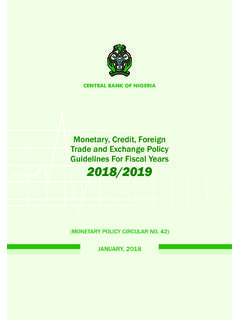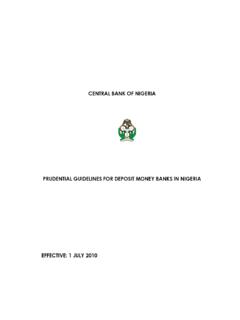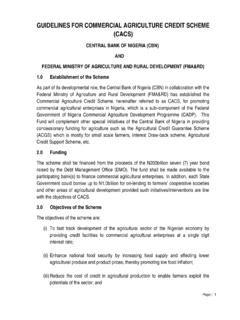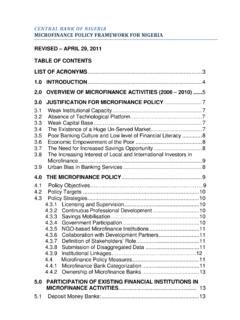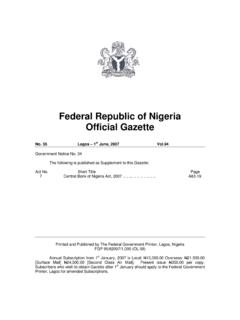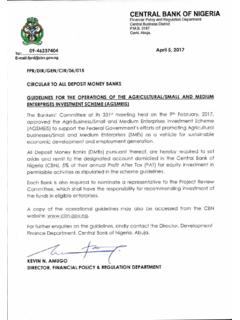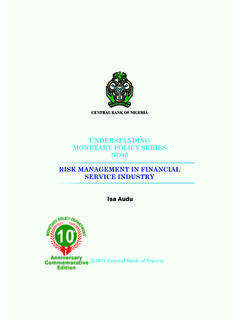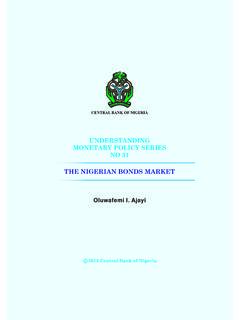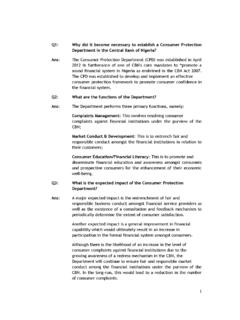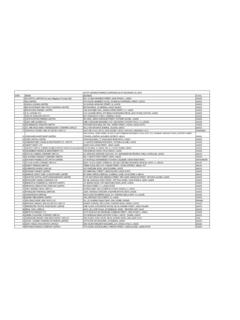Transcription of REVISED REGULATORY AND SUPERVISORY GUIDELINES FOR ...
1 REVISED REGULATORY and SUPERVISORY GUIDELINES for Microfinance Banks in Nigeria Page 1 CENTRAL BANK OF NIGERIA REVISED REGULATORY AND SUPERVISORY GUIDELINES FOR MICROFINANCE BANKS (MFBs) IN NIGERIA DRAFT: 18th December 2012 REVISED REGULATORY and SUPERVISORY GUIDELINES for Microfinance Banks in Nigeria Page 2 Table of Contents INTRODUCTION ..6 Power to Terms and 7 PERMISSIBLE AND PROHIBITED ACTIVITIES .. 9 Permissible 9 Prohibited 10 OWNERSHIP AND LICENSING REQUIREMENTS .. 12 Ownership Licensing Licensing Documentation Application and Licensing 16 Conditions for Grant of Conditions for Final Licence and Commencement of 17 Insurance BOARD AND MANAGEMENT ..19 FUNDING, ACCOUNTING AND RELATED MATTERS ..22 Sources of Books of Rendition of COMPLIANCE WITH MONEY LAUNDERING (PROHIBITION) ACT 2011, TERRORISM (PREVENTION) REVISED REGULATORY and SUPERVISORY GUIDELINES for Microfinance Banks in Nigeria Page 3 ACT 2011 AND KNOW YOUR CUSTOMER (KYC) 25 PUBLICATION OF AUDITED FINANCIAL 26 Procedures and Publication.
2 26 Penalties for Late/False/Inaccurate Returns and Other False/Inaccurate 26 PRUDENTIAL REQUIREMENTS .. 28 General Prudential 28 Special Prudential ASSESSMENT OF 36 REQUIREMENTS FOR INCREASE IN SHARE DISCLOSURE OF INTEREST BY DIRECTORS AND OFFICERS OF DISLOSURE OF REQUIRED INFORMATION TO CREDIT REFERENCE BUREAUX .. 39 OPERATIONAL REQUIRMENTS AND CONTROLS ..40 Opening/Relocation and Closing of Change of Name by Display of Display of Interest Rates and Internal APPOINTMENT OF CHIEF EXECUTIVE/ PRINCIPAL OFFICERS AND EXTERNAL AUDITOR ..42 Appointment of Chief Executive and Principal Appointment and Responsibilities of External SCHEME OF RESTRUCTURING AND RE-ORGANIZATION ..45 REVISED REGULATORY and SUPERVISORY GUIDELINES for Microfinance Banks in Nigeria Page 4 TRANSFORMATION OF OTHER INSTITUTIONS TO MICROFINANCE Deposit Money Banks (DMBs) ..46 Non-Governmental Organizations Microfinance Institutions (NGO-MFIs).
3 47 COLLABORATION TO REGULATE DEPOSIT/SAVINGS MOBILIZING INSTITUTIONS ..50 CONDITIONS FOR REVOCATION OF EXIT CONDITIONS ..52 RECOMMENDED MINIMUM OPERATIONAL TEMPLATE FOR MICROFINANCE BANKS IN REVISED REGULATORY and SUPERVISORY GUIDELINES for Microfinance Banks in Nigeria Page 5 LIST OF ACRONYMS AIP Approval-in-Principle BOFIA Banks and Other Financial Institutions Act CAC Corporate Affairs Commission CAMA Companies and Allied Matters Act CBs Community Banks CBN Central Bank of Nigeria CIBN Chartered Institute of Bankers of Nigeria CRR Cash Reserve Requirement CV Curriculum Vitae DMB Deposit Money Bank FRC Financial Reporting Council GAAP Generally Accepted Accounting Principles KYC Know Your Customer LGA Local Government Area MFB Microfinance Bank MFIs Microfinance Institutions MIS Management Information System NAICOM National Insurance Commission NDIC Nigeria Deposit Insurance Corporation NGO Non-Governmental Organization OFISD Other Financial Institutions Supervision Department PAR Portfolio-at-Risk
4 RBS Risk Based Supervision SEC Securities and Exchange Commission SIID Special Insured Institutions Department REVISED REGULATORY and SUPERVISORY GUIDELINES for Microfinance Banks in Nigeria Page 6 INTRODUCTION The potential of microfinance in poverty reduction, economic growth and development coupled with the emergence of fast growing Microfinance Institutions (MFIs), has effectively put the issue of microfinance on the political agenda of most developing countries. Consequently, the SUPERVISORY authorities have taken active measures to ensure an efficient and effective microfinance delivery through the development of an appropriate REGULATORY and SUPERVISORY framework, based on the peculiar features and associated risks. The challenge that supervisors face is how to accommodate or reasonably encourage microfinance within a framework of generally accepted norms and prudential standards.
5 In general, the GUIDELINES that adequately address the features and risks of microfinance would effectively support the orderly development and sustainability of the institutions to enable them achieve microfinance objectives of financial inclusion and poverty alleviation. The implementation of the Microfinance Policy over the past six (6) years and the experience gained, underscore the need for the review of the existing REGULATORY and SUPERVISORY GUIDELINES . This second edition addresses current realities and developments in the sub-sector. This document is, therefore, aimed at promoting innovative, rapid and balanced growth of the industry, leveraging on global best practice in microfinance banking. These GUIDELINES recognize the distinctiveness of micro clients, ownership structure of the institutions, their credit methodology, and the central position of savings/deposits in the intermediation process.
6 It also adopts measures to ensure the soundness and safety of the institutions, and the protection of depositors, especially low-income clients. Also, it defines institution types, loan documentation, portfolio classification, loan loss provision and write-offs, amongst others, and provides the basis for the establishment, operations, regulation and supervision of microfinance banks, and institutions. Power to Regulate These SUPERVISORY and REGULATORY GUIDELINES are issued by the Central Bank of Nigeria (hereinafter referred to as the CBN or the Bank ) in exercise of the powers conferred on it by the provisions of Section 33 subsection (1)(b) of the CBN Act 7 of 2007 and in pursuance of the provisions of Sections 61-63 of the Banks and Other Financial Institutions Act (BOFIA) 25 of 1991 (as amended). REVISED REGULATORY and SUPERVISORY GUIDELINES for Microfinance Banks in Nigeria Page 7 Terms and Definitions For the purpose of clarity, the following terms and definitions shall be used in the applicable sections of these GUIDELINES .
7 Microfinance Bank A microfinance bank (MFB), unless otherwise stated, shall be construed to mean any company licensed by the CBN to carry on the business of providing financial services such as savings and deposits, loans, domestic fund transfers, other financial and non-financial services to microfinance clients. Microfinance Bank Target Client A microfinance bank target client shall include the economically active low-income earners, low income households, the un-banked and under-served people, in particular, vulnerable groups such as women, physically challenged, youths, micro- entrepreneurs , informal sector operators, subsistence farmers in urban and rural areas. Microenterprise A microenterprise is a business that operates with very small start -up capital. The management is often built around the sole owner or micro-entrepreneur. It provides employment for few people mainly the immediate family members and does not often require formal registration to start .
8 The management and accounting requirements are very simple and flexible. Generally, most micro- entrepreneurs work informally, without business licences or formal records of their activities. The scope of economic activities of micro-enterprises typically includes primary production and crafts, value added processing, distributive trades and diverse services. Microfinance Loan A microfinance loan is granted to the operators of micro-enterprises, such as peasant farmers, artisans, fishermen, youths, women, senior citizens and non-salaried workers in the formal and informal sectors. The loans are usually unsecured, but typically granted on the basis of the applicant s character and the combined cash flow of the business and household. The tenure of microfinance loans is usually within 180 days (6 months). Tenures longer than six (6) months would be treated as special cases. In the case of agriculture, or projects with longer REVISED REGULATORY and SUPERVISORY GUIDELINES for Microfinance Banks in Nigeria Page 8 gestation period, however, a maximum tenure of twelve (12) months is permissible and in housing microfinance, a longer tenure of twenty-four (24) months is permissible.
9 In line with best practice, the maximum principal amount shall not exceed N500,000, or one (1) per cent of the shareholders fund unimpaired by losses and/or as may be reviewed from time to time by the CBN. Microfinance loans may also require joint and several guarantees of one or more persons. The repayment may be on a daily, weekly, bi-monthly, monthly basis or in accordance with amortization schedule in the loan contract. Related Party A related party is an individual or group of individuals that is related in some ways to any of the Directors and Management staff of an MFB. This could include a family member, relative, shareholder, related company or proxy or associates. REVISED REGULATORY and SUPERVISORY GUIDELINES for Microfinance Banks in Nigeria Page 9 PERMISSIBLE AND PROHIBITED ACTIVITIES Permissible Activities An MFB shall be allowed to engage in the provision of the following services to its clients: a.
10 Acceptance of various types of deposits including savings, time, target and demand from individuals, groups and associations; except public sector deposits; b. Provision of credit to its customers, including formal and informal self-help groups, individuals and associations; c. Promotion and monitoring of loan usage among its customers by providing ancillary capacity building in areas such as record keeping and small business management; d. Issuance of redeemable debentures to interested parties to raise funds from members of the public with the prior approval of the CBN; e. Collection of money or proceeds of banking instruments on behalf of its customers including clearing of cheques through correspondent banks; f. Act as agent for the provision of mobile banking and micro insurance services to its clients. g. Provision of payment services such as salary, gratuity, pension for employees of the various tiers of government; h.
